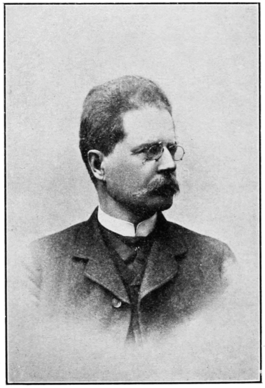rainwater the white, downy "field-wool" waves from dried stems, and from the more shaded niches  S. Lovén. in the granite arise the graceful fronds of ferns. The large black-hooded gray crow flies from hill to hill, while on the ground the pert gray backed white wagtail nods its head and flirts its white bordered tail.
S. Lovén. in the granite arise the graceful fronds of ferns. The large black-hooded gray crow flies from hill to hill, while on the ground the pert gray backed white wagtail nods its head and flirts its white bordered tail.
It was near the end of the eighteenth century when the Danish zoologist, O. F. Müller, made the first trawl in a form still in use for the collection of animals living upon the sea-bottom, and thus began the special study of marine zoology. Fiskebäckskil was visited for zoological research by Professor Bengt Fries in 1835. Four years later Sven Lovén and others joined the colony of naturalists, who worked with such meager facilities as the place could offer. Around the islands in the bays and fjords of the region they found a rich and interesting fauna distributed from  Hjalmar Théel. the shallow flats to depths of eighty fathoms, over bottom varying from rock, sand, shell, clay and ooze, to a carpet of grass and algæ. The foundation here of the Kristineberg Zoological Station by the Royal Academy of Science in 1877 was due to the initiative of Lovén, who had become the most famous and influential Swedish zoologist of the nineteenth century. For almost sixty years Lovén investigated problems in the morphology, comparative anatomy, embryology and taxonomy of various classes of invertebrates, especially of the echinoids, or sea-urchins. He had been a pioneer in Swedish Arctic scientific expeditions and deep-sea exploration, and hence it was fitting that he should suggest the creation
Hjalmar Théel. the shallow flats to depths of eighty fathoms, over bottom varying from rock, sand, shell, clay and ooze, to a carpet of grass and algæ. The foundation here of the Kristineberg Zoological Station by the Royal Academy of Science in 1877 was due to the initiative of Lovén, who had become the most famous and influential Swedish zoologist of the nineteenth century. For almost sixty years Lovén investigated problems in the morphology, comparative anatomy, embryology and taxonomy of various classes of invertebrates, especially of the echinoids, or sea-urchins. He had been a pioneer in Swedish Arctic scientific expeditions and deep-sea exploration, and hence it was fitting that he should suggest the creation
